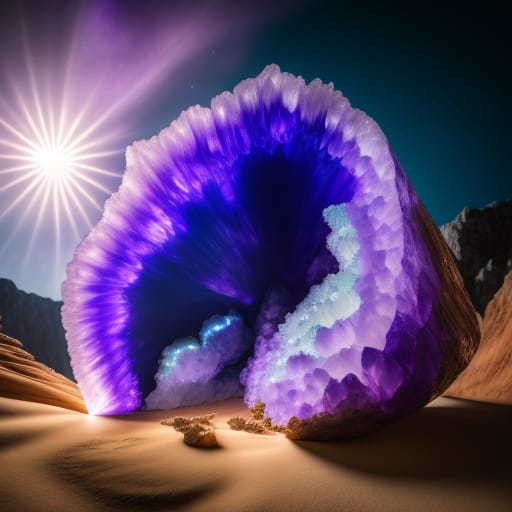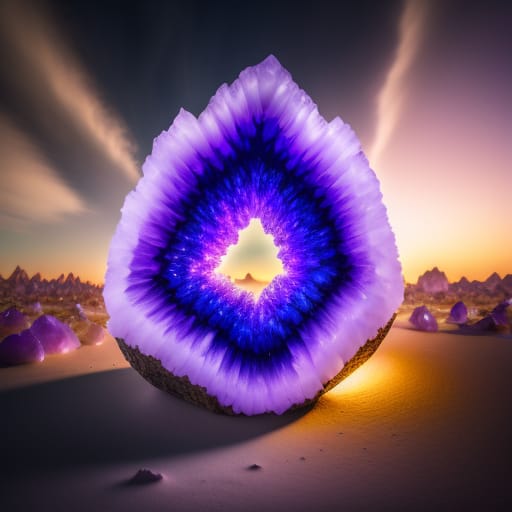Have you ever looked closely at a snowflake and marveled at its intricate, symmetrical beauty? Or gazed in wonder at a glittering gemstone? If so, you’ve experienced the visual magnificence of crystals firsthand. But what exactly are crystals, and how do these stunning structures form?

What is a Crystal?
A crystal is a solid material whose atoms, molecules, or ions are arranged in an orderly, repeating pattern extending in all three spatial dimensions. This crystal structure gives crystals their characteristic smooth, angular surfaces and polyhedral shapes.
The word “crystal” comes from the Ancient Greek word “krustallos,” meaning ice. This is an apt origin, as frozen water molecules arrange themselves in a crystalline structure as they solidify into ice.
Crystals can form from elements, compounds, or mixtures, including minerals, gemstones, metals, salts, proteins, and even DNA. The crystal structure makes the material more stable and uniform than the disorganized arrangement of an amorphous solid like glass.
Key Properties of Crystals
- Highly ordered atomic structure – Atoms align in a repeating or periodic manner called a crystal lattice. This gives crystals their smooth, faceted geometric shapes.
- Symmetry – Many crystals exhibit symmetrical patterns and shapes across axes or planes of orientation. These symmetries define the crystal system.
- Anisotropic – The physical properties of a crystal, like light refraction, may vary along different crystallographic directions.
- Generally solid and stable – The rigid crystal lattice provides strength and durability. Some crystals can withstand extreme pressures and temperatures.
- May contain defects – Imperfections in the ordering of the crystal lattice are called crystallographic defects. These can affect properties.
How Do Crystals Form?
Crystallization is the process by which an ordered crystal structure emerges from a starting state of disorder. There are two main requirements for crystallization to occur:
- A highly concentrated solution – Atoms, ions, or molecules must be crowded closely together in a liquid, gas, or solid matrix.
- Proper conditions – Factors like temperature, pressure, pH, and time must be conducive for ordered particles to align into a lattice as the solution solidifies.
As crystals grow, new particles attach in an orderly manner to the developing lattice. The end result is a solid crystal with a repeating internal arrangement of building blocks.
Stages of Crystal Formation
Crystallization from solution occurs in two main stages:
- Nucleation – Solute particles clustered randomly in solution start to aggregate into ordered assemblies called nucleation sites. These serve as seeds for future crystal growth.
- Crystal growth – Atoms, ions or molecules add onto the existing crystal lattice of the nucleation sites. The crystals become larger and more defined.
Eventually, equilibrium is reached between crystalline solids and solute particles in solution. Crystallization ceases and no further growth occurs.
Classifying Crystals by Structure
The crystal system categorizes crystals by their atomic lattice structure and spatial symmetries. There are 7 crystal systems, further divided into 32 crystal classes.
The 7 Crystal Systems
| Crystal System | Unit Cell | Example |
|---|---|---|
| Cubic | 3 axes of equal length, 90° angles | Halite |
| Tetragonal | 1 long, 2 short axes. 90° angles. | Rutile |
| Orthorhombic | 3 unequal axes, 90° angles | Olivine |
| Hexagonal | 1 long, 6 short axes. 120° angle between short axes. | Quartz |
| Monoclinic | 3 unequal axes. 2 right angles, 1 oblique angle. | Gypsum |
| Triclinic | 3 unequal axes. No right angles. | Rhodonite |
| Rhombohedral | 3 equal axes. Oblique angles. | Calcite |
Space Groups and Point Groups
Within each crystal system, there are additional sub-categories called space groups and point groups that further describe the lattice symmetries. Over 230 space groups have been identified.

Common Types of Crystals
Crystals are everywhere in nature and are common in many industries. Here are some of the most important crystal types:
1. Mineral Crystals
Minerals are crystalline solids formed through geological processes. Some common minerals include:
- Quartz – Silicate mineral found in many types of rock. Used in electronics.
- Calcite – Carbonate mineral that makes up limestones and marbles.
- Halite – A mineral form of table salt (NaCl). Often forms cubes.
- Pyrite – Iron sulfide mineral known as “fool’s gold” for its metallic luster.
- Biotite – Dark mica mineral with layered structure. Found in igneous rocks like granite.
- Olivine – Silicate mineral named for its olive-green color. A major component of the Earth’s mantle.
2. Gemstone Crystals
Gemstones form through geological processes and have desirable physical properties that make them valuable for adornment. Some gemstones include:
- Diamond – Hardest known mineral made of pure carbon. Extremely valuable gemstone.
- Ruby – Red corundum gemstone colored by chromium impurities.
- Emerald – Green gem variety of beryl colored by traces of chromium and/or vanadium.
- Quartz – Abundant gem varieties like amethyst, citrine, and smoky quartz.
- Sapphire – Corundum gemstone that comes in many colors including blue.
- Opal – “Hydrated amorphous silica.” Precious opal exhibits iridescent play-of-color.
3. Salt Crystals
Ionic compounds like sodium chloride form crystalline structures when their aqueous solutions evaporate. Common salt crystals include:
- Table salt (NaCl) – The most familiar example. Granular table salt forms cubic crystals.
- Epsom salts (MgSO4) -Used in bath salts. Often crystallizes as long prisms.
- Sea salt – Formed by the evaporation of seawater. Composed mainly of NaCl crystals.
4. Ice Crystals
Frozen, crystalline form of water molecules (H2O). A complex variety of ice crystal shapes depending on conditions like temperature and humidity.
5. Protein Crystals
Proteins are large biological molecules that perform essential cell functions. X-ray crystallography of protein crystals is important for determining protein structure.
6. Metal Crystals
Metals form crystalline structures like interlocking unit cells when they solidify from molten form. The type of crystal structure affects the metal’s properties.
How Are Crystals Used?
Crystals have applications in science, technology, industry, art, healing practices, and more. Here are some common uses:
- Electronics – Semiconducting crystals like silicon and germanium are essential components of computer chips and solar cells.
- Jewelry – Colorful gemstones and diamonds are prized for jewelry and ornamentation.
- Timekeeping – Quartz crystals regulate the vibration of quartz clocks and watches.
- Imaging – X-ray crystallography enables 3D imaging of molecular and atomic structure.
- Medicine – Insulin and other therapeutic proteins are crystallized and studied to develop drugs.
- Optics – Calcite and quartz crystal prisms and lenses control light refraction in optics.
- Crystal Healing – Crystals are used in alternative healing practices based on purported energy properties.

The Science of Crystallography
Crystallography is the scientific study of crystal structure and its effects on a material’s properties and growth. Important techniques include:
- X-Ray Diffraction – X-rays beamed at a crystal produce a diffraction pattern that reveals the crystal lattice.
- Single Crystal XRD – X-ray analysis of one pristine crystal gives precise structural data.
- Powder XRD – A polycrystalline powder sample provides averaged diffraction info.
- Electron & Neutron Diffraction – Reveals structure by diffraction of electrons or neutrons.
- Crystal Growth – Techniques to grow large, high-quality single crystals for analysis.
- Crystallographic Databases – Catalog crystal structures. The Cambridge Database has over 1 million entries.
Advanced crystallography sheds light on the atomic structure of materials from metals to complex biological molecules like proteins. This aids the design of new crystalline materials with desired properties.
Conclusion
Crystalline structures arise throughout nature, from the growth of a snowflake to the carbon lattice of a diamond. Understanding the ordered arrangement of atoms and molecules within crystals helps scientists decipher the properties of matter on a fundamental level.
The repeating submicroscopic architecture of crystals also results in their outward smoothness, symmetry, solidity, and geometric beauty—properties that make them invaluable for scientific research and human industry. So next time you see a crystal, admire both its visual perfection and hidden intricacy!
I hope this comprehensive beginner’s guide gives you a helpful overview of the essential things to know about crystals! Let me know if you have any other questions.
Frequently Asked Questions
What’s the difference between a crystal and a mineral?
A mineral is a naturally occurring crystalline solid formed through geological processes. So all minerals have a crystalline structure, but not all crystals are minerals. Other crystals like gemstones or metals can form through other means besides geology.
How do crystals get their color?
The color of a crystal often comes from chemical impurities within the crystal lattice. Certain impurity atoms can absorb or emit specific wavelengths of light, causing the crystal to appear a certain color. Other factors like crystal defects can also affect color.
Can crystals really heal?
Crystal healing relies on the folkloric belief that crystals emit beneficial energy fields that can restore health and well-being. There is no scientific evidence that crystals have healing powers, but some people report feeling better after participating in crystal healing practices.
What are semi-precious stones?
In gemology, the term semi-precious stone refers to any gemstone that isn’t classified as one of the “big four” precious stones: diamond, ruby, emerald, and sapphire. Semi-precious stones include popular gems like amethyst, citrine, garnet, and many more.
How do snowflakes get their shape?
Snowflake crystals grow by water vapor molecules attaching to the crystal lattice in an ordered, symmetrical way based on the surrounding temperature, humidity, and other conditions. The complex variety of snowflake shapes arises from these subtle environmental differences during crystal growth.